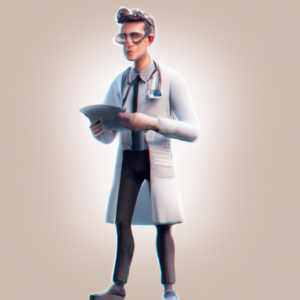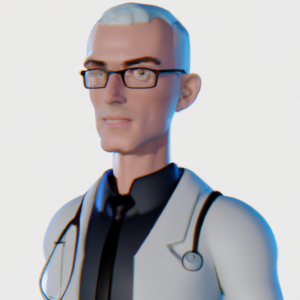Digital Twins Revolutionize Healthcare in Metaverse

The healthcare industry is on the cusp of a revolution, thanks to digital twins. These virtual replicas of real-world objects and systems have been around for some time, but their application in healthcare is relatively new. As healthcare increasingly moves into the digital realm, digital twins offer an innovative solution for personalized healthcare. The metaverse, a virtual reality space where people can interact with each other and digital objects, is the perfect environment for digital twins to thrive. In this article, we will explore what digital twins are, how they are reshaping healthcare, and the potential for their future use in the industry.
What are Digital Twins?
Digital twins are virtual replicas of physical objects or systems. They are created by gathering data from sensors, simulations, and other sources to create a dynamic 3D model of the object or system. This virtual model can be used to monitor, analyze, and optimize the physical object or system in real-time. In healthcare, digital twins can be used to create personalized models of patients’ bodies, organs, and diseases. These models can be used to predict the progression of diseases, monitor treatment effectiveness, and improve diagnosis and treatment.
Healthcare’s Metaverse: The Future of Digital Twins
The metaverse is a virtual reality space where people can interact with each other and digital objects. It offers a new frontier for digital twins in healthcare. Patients can create avatars that interact with their digital twin, allowing them to visualize and understand their health conditions better. Doctors and healthcare providers can also use the metaverse to interact with patients and their digital twins, allowing them to monitor and adjust treatment plans in real-time.
How Digital Twins are Reshaping Healthcare

Digital twins are revolutionizing healthcare in several ways. They provide personalized healthcare, allowing doctors to create virtual replicas of patients’ bodies and organs to monitor and analyze health conditions in real-time. They also allow doctors to create treatment plans tailored to individual patients. Additionally, digital twins can be used to simulate medical procedures and surgeries, improving patient outcomes and reducing risks.
In the digital age, healthcare providers are using a range of technologies to improve patient care. Digital twins are one of the most recent innovations being employed in healthcare. The technology is being used to create virtual replicas of organs, tissues, and even entire patients. These digital twins are used to simulate real-world scenarios, allowing doctors to make accurate diagnoses and prescribe effective treatments.
Digital twins are created by combining data from various sources, including medical records, imaging scans, and genetic data. The data is then used to create a virtual replica of the patient or a specific part of the patient’s body. The virtual replica can be used to simulate different scenarios, such as the effects of medication or surgical procedures on the patient. This simulation allows doctors to identify potential complications before they arise and prescribe an effective treatment plan.
Digital twin technology is poised to revolutionize healthcare in the coming years. The technology is already being used in patient care, medical research, and surgical outcomes. In the future, digital twins are expected to play an even bigger role in personalized medicine, remote patient monitoring, and precision surgery.
The Power of Twins: Revolutionizing Patient Care
Digital twins are being used to revolutionize patient care in numerous ways. For example, doctors can use digital twins to identify the best treatment for a patient based on their specific medical history and genetic makeup. Additionally, digital twins are being used to predict potential complications during surgery, allowing doctors to take preventive measures before the surgery begins.

Digital Twins: A Game-Changer for Medical Research
Digital twins are also being used to advance medical research. For example, researchers can use digital twins to test the effectiveness of new medication or medical devices before testing them in humans. This simulation allows researchers to identify potential complications before they arise and make necessary adjustments.
Digital Twins for Personalized Medicine: A Promising Tool
Personalized medicine is an emerging field that aims to provide patients with tailored treatment plans based on their specific medical history and genetic makeup. Digital twins are a promising tool in this field as they can be used to identify the best treatment plan for a patient based on their unique characteristics.
Remote patient monitoring is another area that is benefiting from digital twin technology. Digital twins can be used to monitor patients remotely, allowing doctors to track their health status and adjust their treatment plan accordingly. This technology is particularly useful for patients with chronic conditions who require constant monitoring.
Digital twins are being used to enhance surgical outcomes by providing doctors with a better understanding of the patient’s anatomy before the surgery begins. This understanding allows doctors to plan the surgery more effectively, reducing the risk of complications and improving patient outcomes.
The Role of AI in Advancing Digital Twin Technology
Artificial intelligence (AI) plays a crucial role in digital twins. AI algorithms can analyze data from digital twins to identify patterns and predict outcomes. This information can be used to improve diagnosis and treatment of diseases. Additionally, AI can be used to simulate medical procedures and surgeries, reducing risks and improving patient outcomes.
The Ethical Implications of Digital Twins in Healthcare
As with any emerging technology, there are ethical implications to consider when it comes to digital twins in healthcare. For example, there are concerns about data privacy, informed consent, and potential biases in the algorithms used to analyze medical data. It is essential to address these concerns to ensure that the benefits of digital twin technology are realized without compromising patient rights.
In conclusion, digital twins are transforming healthcare by providing doctors with a better understanding of patient anatomy, allowing for more accurate diagnoses, and prescribing more effective treatments. The technology is also being used to revolutionize medical research, personalized medicine, and remote patient monitoring. While there are ethical implications to consider, the benefits of digital twin technology are undeniable. With continued advancements in AI and data analytics, the future looks bright for digital twins in healthcare.
Benefits of Digital Twins in Healthcare
Digital twins offer several benefits to the healthcare industry. They provide personalized healthcare, allowing doctors to create virtual replicas of patients’ bodies and organs to monitor and analyze health conditions in real-time. They also allow doctors to create treatment plans tailored to individual patients. Additionally, digital twins can be used to simulate medical procedures and surgeries, improving patient outcomes and reducing risks.
Improved Diagnosis and Treatment with Digital Twins
Digital twins can improve diagnosis and treatment of diseases. They can be used to create virtual replicas of organs, allowing doctors to simulate diseases and test treatment options before administering them to patients. Digital twins can also be used to monitor treatment effectiveness in real-time, allowing doctors to adjust treatment plans as needed.
Managing Patient Health with Digital Twins
Digital twins can be used to manage patient health. They provide doctors with real-time data on patients’ health conditions, allowing them to monitor and adjust treatment plans as needed. Patients can also interact with their digital twins, allowing them to better understand their health conditions and manage their own health.
Security Concerns with Digital Twins in Healthcare
Digital twins raise security concerns in healthcare. Personal health information is sensitive, and digital twins must be protected from cyberattacks and breaches. Healthcare providers must ensure that digital twins are stored securely and that access to them is restricted to authorized personnel only.
Future Applications of Digital Twins in Healthcare
The potential applications of digital twins in healthcare are vast. They can be used to predict disease outbreaks, monitor public health, and improve healthcare delivery. Digital twins can also be used to simulate medical procedures and surgeries, allowing doctors to train and improve their skills without risking patients’ lives.
The Promising Future of Digital Twins in Healthcare===
The rise of digital twins in healthcare is a promising development. They offer personalized healthcare, improved diagnosis and treatment, and improved patient outcomes. As the healthcare industry continues to move into the digital realm, digital twins will play an increasingly important role in shaping the future of healthcare. With the potential for improved patient outcomes and reduced costs, the future of digital twins in healthcare is bright.
References and Further Reading on Digital Twins in Healthcare
- “Digital Twins in Healthcare: The Future is Now” by Arjun Sethi, Forbes
- “Digital Twins in Healthcare: An Overview” by Saptarshi Purkayastha, Medium
- “The Metaverse is Coming for Medicine” by Arjun Sethi, Wired
- “Digital Twins and the Future of Healthcare” by Zaid K. Al-Jamea, Medium
- “Digital Twins in Healthcare: Opportunities and Challenges” by Nader Mirzadeh, IEEE Access